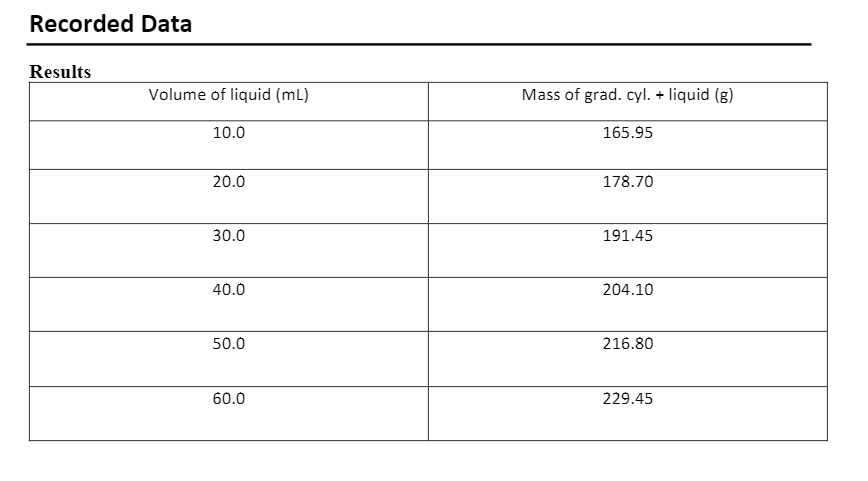Experimental Procedure Graphing 1. Obtain a 100 mL graduated cylinder. Add 10.0 mL of the liquid to be analyzed to the cylinder and obtain the mass. Write this mass on the results table. NOTE: it does not have to be exactly 10.0 mL. If something other than 10.0 mL is added, note that change on the data table. 2. Continue to add 10mL portions of liquid to the cylinder and obtain the mass each time. Write the cumulative volume, making sure to measure your total volume accurately with each addition, and its corresponding mass in the table. DO NOT EMPTY THE CYLINDER BETWEEN ADDITIONS OF LIQUID. 3. Dispose of the liquid in the appropriate container in the fume -hood. 4. Draw a graph of mass versus volume. Use the guidelines set forth in the example. Make sure the graph takes up as much of the graph paper as possible Graphing Increments For the X-axis: Highest X value –Lowest X value/ #of boxes(15) =____ Round up to____ Increments For the Y-axis:Highest Y value –Lowest Y value/# of boxes(20)= ___Round up to ____ Start numbering the X axis at 0 Start numbering the Y axis at ______ Points used to obtain slope (must NOT be data points)________ and_______ Slope=______ =_________ (with units) Y- intercept = Equation of the line = The slope represents the____________of the liquid. The y-intercept is the_______of the________. .
Experimental Procedure Graphing 1. Obtain a 100 mL graduated cylinder. Add 10.0 mL of the liquid to be analyzed to the cylinder and obtain the mass. Write this mass on the results table. NOTE: it does not have to be exactly 10.0 mL. If something other than 10.0 mL is added, note that change on the data table. 2. Continue to add 10mL portions of liquid to the cylinder and obtain the mass each time. Write the cumulative volume, making sure to measure your total volume accurately with each addition, and its corresponding mass in the table. DO NOT EMPTY THE CYLINDER BETWEEN ADDITIONS OF LIQUID. 3. Dispose of the liquid in the appropriate container in the fume -hood. 4. Draw a graph of mass versus volume. Use the guidelines set forth in the example. Make sure the graph takes up as much of the graph paper as possible Graphing Increments For the X-axis: Highest X value –Lowest X value/ #of boxes(15) =____ Round up to____ Increments For the Y-axis:Highest Y value –Lowest Y value/# of boxes(20)= ___Round up to ____ Start numbering the X axis at 0 Start numbering the Y axis at ______ Points used to obtain slope (must NOT be data points)________ and_______ Slope=______ =_________ (with units) Y- intercept = Equation of the line = The slope represents the____________of the liquid. The y-intercept is the_______of the________. .
Principles of Instrumental Analysis
7th Edition
ISBN:9781305577213
Author:Douglas A. Skoog, F. James Holler, Stanley R. Crouch
Publisher:Douglas A. Skoog, F. James Holler, Stanley R. Crouch
Chapter29: Supercritical Fluid Chromatography And Extraction
Section: Chapter Questions
Problem 29.1QAP
Related questions
Question
Experimental Procedure Graphing
1.
Obtain a 100 mL graduated cylinder. Add 10.0 mL of the liquid to be analyzed to the cylinder and obtain the mass. Write this mass on the results table. NOTE: it does not have to be exactly 10.0 mL. If something other than 10.0 mL is added, note that change on the data table.
2.
Continue to add 10mL portions of liquid to the cylinder and obtain the mass each time. Write the cumulative volume, making sure to measure your total volume accurately with each addition, and its corresponding mass in the table. DO NOT EMPTY THE CYLINDER BETWEEN ADDITIONS OF LIQUID.
3.
Dispose of the liquid in the appropriate container in the fume
-hood.
4.
Draw a graph of mass versus volume. Use the guidelines set forth in the example. Make sure the graph takes up as much of the graph paper as possible
Graphing
Increments
For the X-axis: Highest X value –Lowest X value/ #of boxes(15) =____
Round up to____
Increments
For the Y-axis:Highest Y value –Lowest Y value/# of boxes(20)= ___Round up to ____
Start numbering the X axis at 0
Start numbering the Y axis at ______
Points used to obtain slope (must NOT be data points)________ and_______ Slope=______ =_________ (with units)
Y- intercept =
Equation of the line =
The slope represents the____________of the liquid.
The y-intercept is the_______of the________.
.

Transcribed Image Text:Recorded Data
Results
Volume of liquid (mL)
Mass of grad. cyl. + liquid (g)
10.0
165.95
20.0
178.70
30.0
191.45
40.0
204.10
50.0
216.80
60.0
229.45
Expert Solution
This question has been solved!
Explore an expertly crafted, step-by-step solution for a thorough understanding of key concepts.
This is a popular solution!
Trending now
This is a popular solution!
Step by step
Solved in 2 steps with 1 images

Knowledge Booster
Learn more about
Need a deep-dive on the concept behind this application? Look no further. Learn more about this topic, chemistry and related others by exploring similar questions and additional content below.Recommended textbooks for you

Principles of Instrumental Analysis
Chemistry
ISBN:
9781305577213
Author:
Douglas A. Skoog, F. James Holler, Stanley R. Crouch
Publisher:
Cengage Learning

Chemistry for Today: General, Organic, and Bioche…
Chemistry
ISBN:
9781305960060
Author:
Spencer L. Seager, Michael R. Slabaugh, Maren S. Hansen
Publisher:
Cengage Learning

Chemistry: Matter and Change
Chemistry
ISBN:
9780078746376
Author:
Dinah Zike, Laurel Dingrando, Nicholas Hainen, Cheryl Wistrom
Publisher:
Glencoe/McGraw-Hill School Pub Co

Principles of Instrumental Analysis
Chemistry
ISBN:
9781305577213
Author:
Douglas A. Skoog, F. James Holler, Stanley R. Crouch
Publisher:
Cengage Learning

Chemistry for Today: General, Organic, and Bioche…
Chemistry
ISBN:
9781305960060
Author:
Spencer L. Seager, Michael R. Slabaugh, Maren S. Hansen
Publisher:
Cengage Learning

Chemistry: Matter and Change
Chemistry
ISBN:
9780078746376
Author:
Dinah Zike, Laurel Dingrando, Nicholas Hainen, Cheryl Wistrom
Publisher:
Glencoe/McGraw-Hill School Pub Co


World of Chemistry, 3rd edition
Chemistry
ISBN:
9781133109655
Author:
Steven S. Zumdahl, Susan L. Zumdahl, Donald J. DeCoste
Publisher:
Brooks / Cole / Cengage Learning